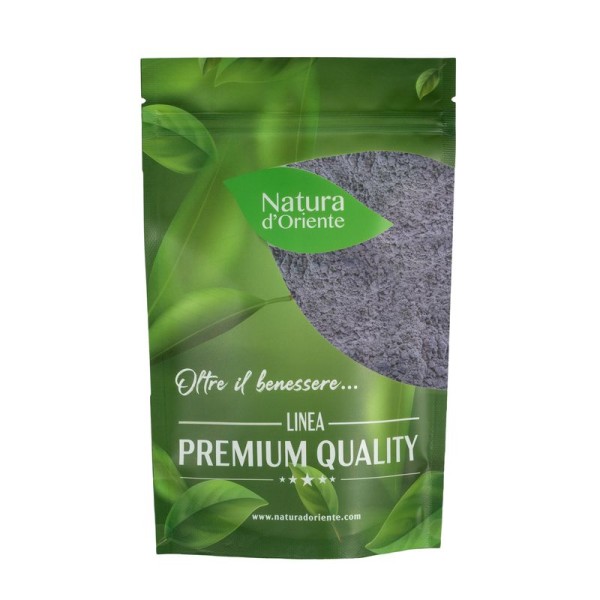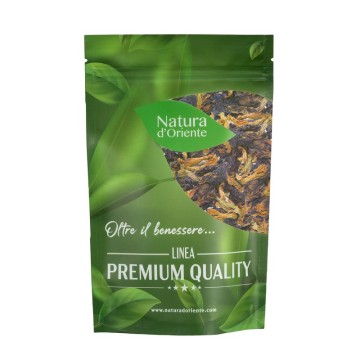Clitoria Ternatea is a plant known for the beneficial and coloring effects of its flowers. Available in this version without artificial flavors or colourings, the flower powder is considered a scenographic element, as a natural blue food colouring. Excellent for creating a colorful drink or recipe, still rich in antioxidants.
Butterfly pea herbal tea is considered a natural source of anthocyanins and flavonoids, giving a sweet and delicate, slightly earthy flavor (hint of peas taste). .
Blue pea flower powder: properties and benefits
The pea powder gives a brilliant shade of blue, which has often been used as a natural colorant for cocktails and herbal teas – reminiscent of the famous Prussian blue. It changes color with the acidity of the infusion, and for this reason it represents an element known for the creation of particular cocktails, with an intense blue color that can turn towards purple by adding other ingredients based on the pH. Pea flower powder is also used as a food coloring for rice, sauces, desserts or other recipes.
In terms of well-being, the flower is also known for its content of flavonoid antioxidants, which help our body to counteract free radicals. In particular, blue flowers take their color from anthocyanins - antioxidants that promote correct blood circulation by stimulating certain vasodilator agents. Some elements contained in the Butterfly Pea flower are considered useful for the well-being of the skin and hair, increasing hydration. The content of vitamins A and C, which contribute to skin beauty, is strengthened by other minerals such as potassium, zinc and iron. In practice, pea flowers give a beneficial soothing and hydrating impact on the skin, and with their richness in anthocyanins they also help blood microcirculation, useful for the beauty and tone of the epidermis.
For this reason, some cosmetics incorporate blue pea flowers into shampoos, facial tonics or creams.
At a food level, we remind you that Butterfly Pea flower powder does not contain dyes or preservatives, and can be mixed in water to every use.
Origins and history of cultivation
The blue pea, also called butterfly pea or bula telang, is a plant native to Asia, historically cultivated in south-east Asia and Thailand. The origin can be traced back to the island of Ternate, in eastern Indonesia (Molucca Sea) - in fact, botanically it is the Clitoria ternatea. The plant gets its English name from the butterfly shape of the large blue flowers. In the classic version, the name Clitoria derives from the shape associated with the female genital organ. In traditional Chinese medicine (TCM) they have been considered for centuries as phytotherapy remedies. They were flowers suitable for the cold nature, with a bitter taste that gives an affinity with the meridians of the large intestine and liver. Among some populations, butterfly pea flowers were believed to have an aphrodisiac effect, and in India Butterfly Pea herbal tea was used to relax and treat agitation. Today the flowers are used for the preparation of sweets, desserts, healthy smoothies, colorful drinks or cocktails. The flowers are very popular for infusion, often together with other ingredients such as honey and lemon.
Plant and flowers
The Clitoria ternatea, blue pea or cordofan pea is a species that belongs to the Fabaceae (legume) family.
It grows spontaneously at the edges of forests or near the banks of rivers, while it is cultivated as an ornamental plant or to fix nitrogen to the soil - as the pea is a legume. The intense blue flowers, with white shades, precede the fruits: flattened pods containing 6 to 10 seeds per pod. The seeds or peas can be eaten fresh when they are tender, and the flowers are also edible.
Nutritional values of Butterfly Pea flower powder
The flowers are rich in anthocyanin compounds called ternatines, and antioxidants including the flavonoid kaempferol. Other elements considered useful in blue pea flower powder are p-coumaric acid, and delphinidin-3,5-glucoside. Butterfly Pea flowers also contain vitamins A and C, which contribute to healthy vision and skin. They also contain potassium, zinc and iron.
How to use Butterfly Pea flower powder
The powder, when wet, turns a vibrant blue color. The knowspore is delicate with some sweet and floral notes, perfect for various recipes based on Butterfly Pea. Among drinks, it is known for alcoholic or non-alcoholic cocktails, shakes, smoothies; while it is used in cooking for sauces, desserts, rice, desserts and cakes, donuts, yogurt, etc. Fabulous for pigmenting baked products such as bread, donuts, brioche and muffins.
Compared to the use of Butterfly Pea flowers, blue pea powder has an advantage of practicality and versatility in recipes. In application it has an instant effect, since it is mixed directly. In storage it lasts much longer than flowers, if correctly preserved airtight.
Furthermore, the powder has a lower cost as it is concentrated, for the same weight. A little of this concentrated powdered extract is enough to give an intense blue and change the flavor of the dish. Usually, half a teaspoon of powder is added to the dough, to dye it blue naturally. You would need more flowers than Butterfly Pea powder to achieve the same food coloring effect.
The acidity of citrus fruits (if you add lemon or lime) can cause the flower powder to take on a shade closer to deep purple , to the drink. If you stimulate the Butterfly Pea with the pH of plant milk, the blue acquires brilliance. Just half a teaspoon added to the powders of the mixture dyes them blue or bright purple in a completely natural way.
Butterfly Pea flower powder: side effects and contraindications
The pea flower is generally considered safe, if the recommended doses are respected. In case of excessive intake, side effects such as diarrhea, nausea, stomach pain are possible. It is not recommended for pregnant or breastfeeding women.













 No reward points for this product.
No reward points for this product.
